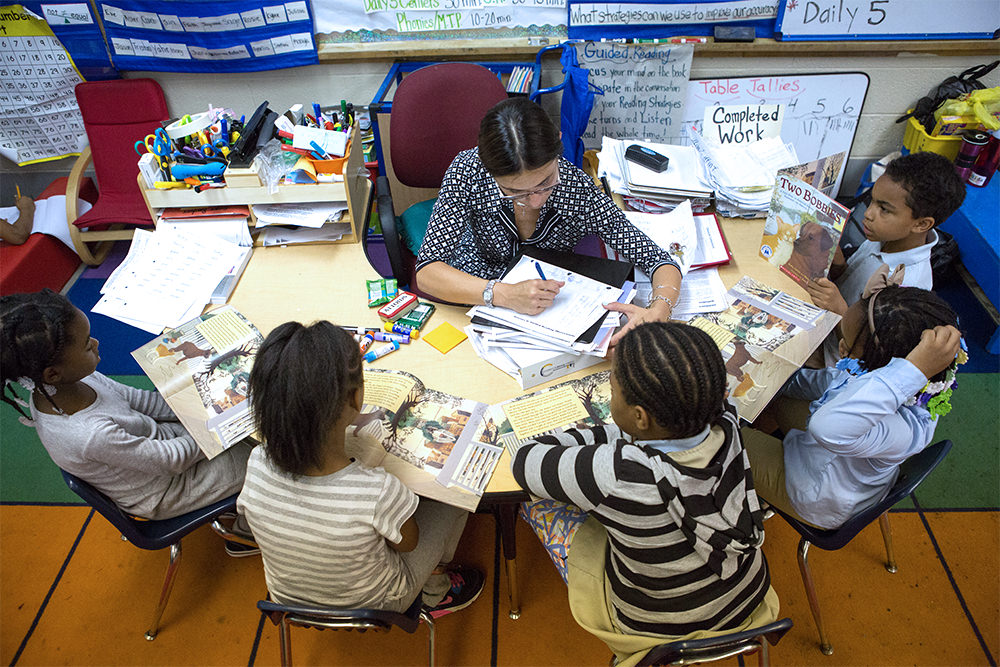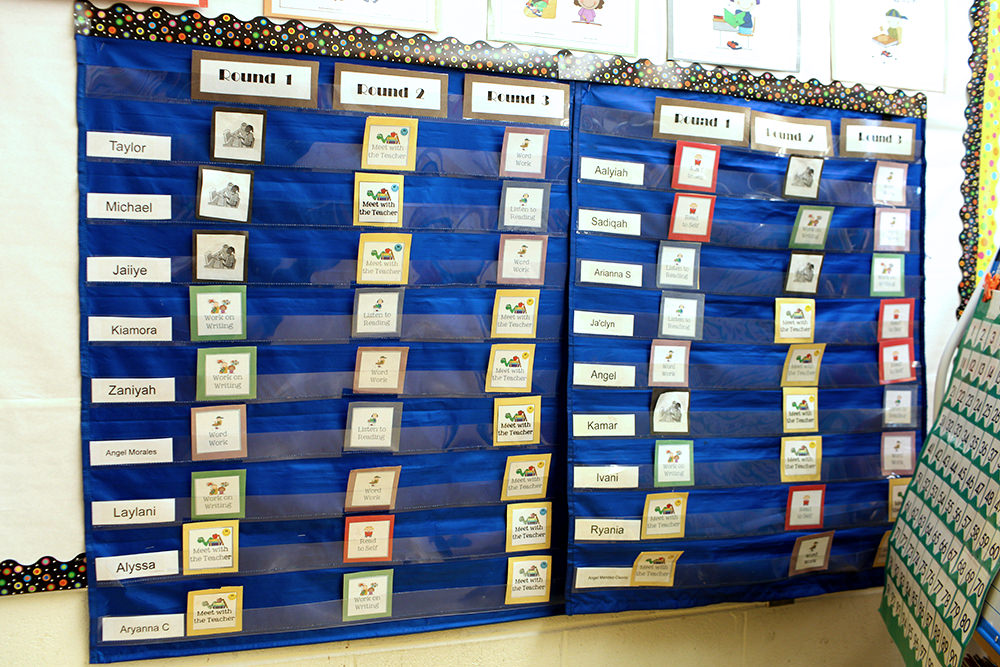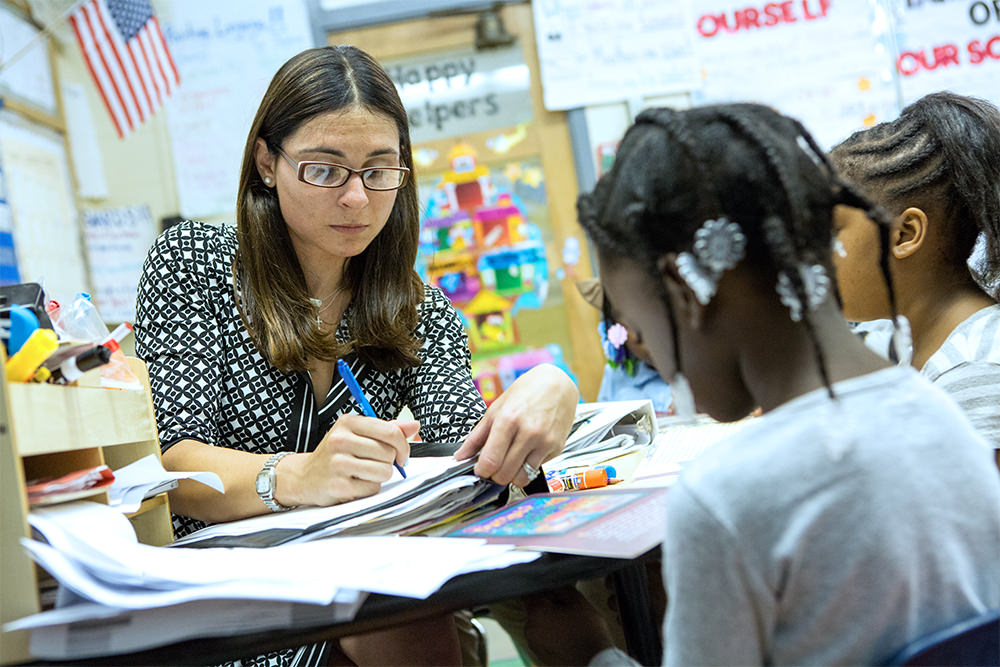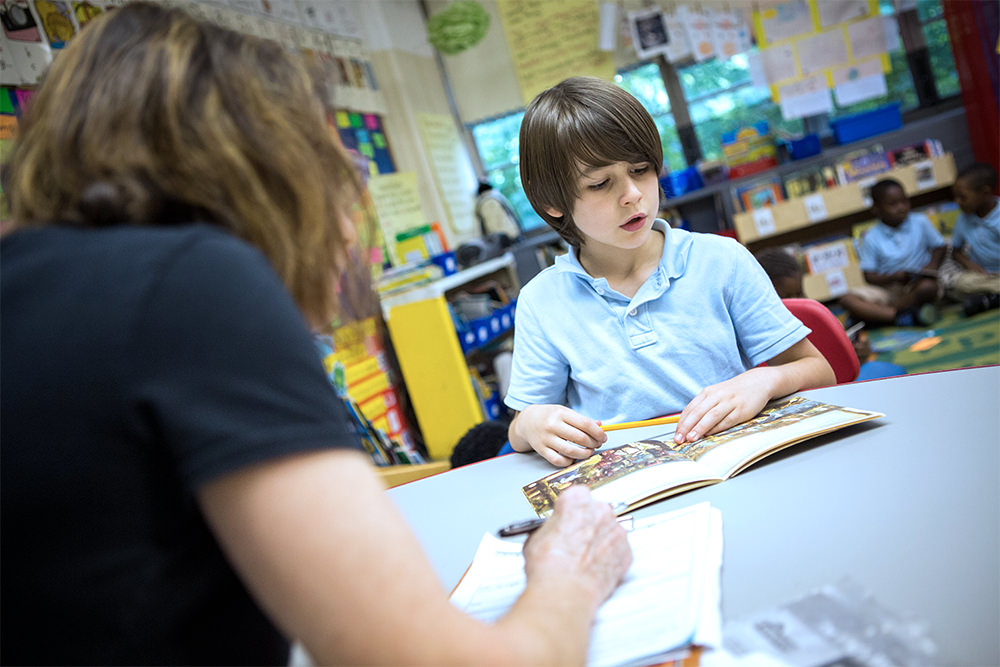Getting Started with Guided Reading
Ready to get started? Here are the first steps you can take to build, change, or enhance this instructional practice in your classroom.
Form groups based on assessment data.
When children are placed in groups based on their instructional reading level using multiple sources of data, they are ensured access to instruction that meets their needs in the most efficient and effective ways. Group discussion and collaboration are most effective when instruction occurs in the company of peers who share strengths and needs. Re-grouping often is necessary to ensure that children are continually matched with the right peers, objectives, and texts.
- Administer a reliable assessment (DRA, Benchmark, etc.) and analyze the results.
- Examine formative assessment data (e.g., running records, anecdotal notes, writing samples, etc.) to identify children’s strengths and needs.
- Use information from all of these sources to form groups.
- Re-assess and re-group as necessary.
Choose an instructional level text to match the objective of the lesson and the readers’ interest.
 A hallmark of Guided Reading is working with an instructional level text, i.e., a text that the children can read with 90-94% accuracy. The use of an instructional level text allows for optimal teaching and learning. The children will be able to read most of the text, but there are still opportunities for instruction. Guided Reading lessons are focused on an objective informed by child data and in line with realistic text level expectations. Lessons driven by an objective are purposeful and productive. The teacher keeps track of the children’s progress toward the objective using anecdotal notes of the children’s reading behaviors to inform future lessons. A book in an area of the children’s interest increases their level of engagement and motivates them to work harder.
A hallmark of Guided Reading is working with an instructional level text, i.e., a text that the children can read with 90-94% accuracy. The use of an instructional level text allows for optimal teaching and learning. The children will be able to read most of the text, but there are still opportunities for instruction. Guided Reading lessons are focused on an objective informed by child data and in line with realistic text level expectations. Lessons driven by an objective are purposeful and productive. The teacher keeps track of the children’s progress toward the objective using anecdotal notes of the children’s reading behaviors to inform future lessons. A book in an area of the children’s interest increases their level of engagement and motivates them to work harder.
Set a literacy objective based on your review of both formative (e.g., running records, anecdotal notes, etc.) and standardized assessment data, standards, and professional texts (e.g., The Continuum of Literacy Learning, The Next Step in Guided Reading) which provide text level expectations.
Choose an instructional level text that offers sufficient opportunity to address the objective.
Be mindful of topics, authors, and series that have generated a positive response in the past. If possible, select a book representing favorite topics, authors, and series. However, a book that matches the objective is the first priority.
Use a lesson planning template to guide the thoughtful planning and pacing of the lesson and rehearse language

The lesson planning template is a tool for supporting your thinking through this important phase of a Guided Reading lesson. Successful lessons only happen with careful planning. The prompts ensure that your lesson addresses all of the critical components of the lesson’s objective. On the lesson planning template, you will record the actual language that you’ll use when teaching the lesson. This will help to conserve time and ensure a high quality lesson. Guided Reading lessons are 15-20 minutes long, and the lesson planning template will support you in being mindful of how much time you must allocate to each segment.
Gather all of the lesson materials (e.g. texts, letter cards, etc.) and formative assessment data.
Carefully read through the selected text to make sure that it offers ample opportunity to practice the skill or strategy that will be the focus of the lesson.
Follow the prompts and questions to complete the planning template.
Rehearse the language for the lesson, giving special attention to the “before reading” segment (i.e., text introduction, purpose setting, and teaching point demonstration).
Time the rehearsal to ensure that this lesson can be done and within the 15-20 minute time frame.
Invite your coach or a colleague to observe the lesson rehearsal and give you feedback.
Guided Reading Lesson Plan Template
Use this lesson plan template to guide your own planning.
Guided Reading Lesson Plan Template (Spanish)
Use this lesson plan template to guide your own planning.
Develop routines and procedures to promote responsibility within the Guided Reading group.
Children who are comfortable and confident with the routines and procedures of Guided Reading will experience a higher degree of success in applying them to their independent reading. The “before reading” segment of the lesson is where sufficient time and instruction should be devoted to learning the routines and procedures of Guided Reading. The emphasis on procedures and routines will decrease over time to simply a brief reminder. Practicing procedures and routines will result in more productive and smoother lessons, increased reading progress, and independence in reading.

Plan and reflect upon the procedures and routines needed for Guided Reading (e.g., whisper reading, repeated reading, what to do when you come to the Guided Reading table, etc.) Use the procedural lesson planning template.
Teach the procedural lessons. For each procedure, this might include co-creating an anchor chart.
Post the anchor chart(s) in the Guided Reading area.
Reread the anchor chart(s) as needed before Guided Reading lessons.
Practice routines as needed.
Begin each Guided Reading lesson with a brief review of one of the routines or procedures.
Highlight children who are doing a good job following routines and procedures during Guided Reading.
At the end of lesson, have the children reflect on how well they carried out the procedures.
Develop routines and procedures to promote responsibility for children working independently (who are not in the Guided Reading group.)
Guided Reading takes place in an environment of immersed readers and writers. You can’t successfully move forward with a Guided Reading lesson until the children who are not at the Guided Reading table are meaningfully engaged in independent reading and writing tasks. You must be able to exclusively devote your attention to the children at the Guided Reading table. Through a series of carefully planned, taught, and practiced procedural lessons, the children working independently learn what to do, where to do it, how to access materials, and how to solve the problems that are likely to emerge. They become increasingly more self-directed, self-regulated, and independent. This serves them well not only during Guided Reading, but also throughout the literacy block and the rest of the school day.
Using the procedural lesson template, plan the procedures and routines that need to be in place for Independent Work Time (e.g., how to use the CD player, how to operate the iPad, what to do if your pencil breaks, how to rotate to the next station, etc.)
Teach the procedural lessons. For each procedure, this might include co-creating an anchor chart.
Post the anchor chart(s) in the areas where they are needed.
Practice, role play, and rehearse as needed.
Briefly review routines and procedures for Independent Work Time each day before taking any Guided Reading groups.
Check in with the children between Guided Reading lessons.
Highlight the children and the groups that are engaged in the expected behaviors.
Develop a child-friendly rubric so the children can self-monitor and self-assess.
Reteach procedural lessons as needed.
Have a whole class reflection at the end of Guided Reading/Independent Work Time.
Address problems in class meetings.
Create a joyful climate around learning to read.

When we teach children to read, one of the most important lessons we convey is that reading is fun! If they don’t believe that reading is fun, they won’t put in the time, effort, and persistence necessary to become fluent readers. Make it worth their while. The climate that we create in our classrooms greatly contributes to children’s motivation to read. Share memorable characters, gorgeous illustrations, and clever story lines. Then put the books in their hands, support them in their reading, and let them have fun.
Read aloud books with proven kid-appeal. Let your children know what they’ll get when they learn to read. Highlight the high interest books in your classroom library.
Select books that children will like for Guided Reading whenever possible. Keep track of the authors, characters, series, and topics that appeal to your children.
Keep the books for Guided Reading instruction in the children’s instructional range. Nothing takes the joy out of reading like laboring through a book that is too difficult.
When possible, choose books that can be easily converted into readers’ theater scripts. The children will build fluency through repeated readings and have fun performing for their friends.
Try comics and graphic novels for early readers.
Plan appealing extension book activities. Let your children draw, sing, write, and act in response to their books.
Introduce and preview the text, varying the length and type of book introduction by reading stage.
A successful book introduction equips readers with the tools and information that they will need to read a text. The book introduction occurs in the “before reading” segment of the lesson. Book introductions consider the children’s background knowledge, the structure of the text, the lesson focus, and words and phrases that are critical to successfully reading the book. The length of a book introduction varies based on the children’s reading stage, their familiarity with the text type, and their experience with reading books at that particular text level.
Examine the selected text (e.g., needed background knowledge, structure, vocabulary) to determine the focus of its introduction.
Plan, prepare, and rehearse the book introduction.
Read the title of the book to the children. Give a two or three sentence overview of the book.
Distribute the book and guide the children through it, emphasizing what you focused on in your introduction, as follows:
- Guide emergent readers through almost the entire book, having them point to the critical words in the book.
- Early readers will need to be guided through only about one third of the book.
- Transitional and fluent readers will require only a succinct overview.
Be mindful of the time spent on the book introduction in a 15-20 minute lesson.
Briefly listen to and work with one reader at a time, while other children are reading.
The “guiding” of the Guided Reading lesson occurs in the “during reading” segment of the lesson. Every child has a book and is whisper reading. It is the children’s opportunity to apply and practice the skills and strategies that you have taught them. It is your opportunity to observe them and notice what skills and strategies they are successfully applying. You are listening in and briefly conferring with one reader at a time. During this brief conference, you notice the child’s reading behaviors and confirm the strategy (e.g., “You checked the picture, then tried the word.”), or you step in and scaffold (e.g., “Does that make sense? What can you try instead?”). The conferences provide pertinent information for future lessons and some feedback that can help you reflect retrospectively upon your book selection and book introduction. Anecdotal notes taken during the conferences will inform future lessons.

Prepare a binder or notebook for taking anecdotal notes. Be sure to record the date, the book title, and the text level.
Tell the children to open the book and whisper read.
Listen in on each reader.
Conduct a brief conference with each reader in which you might:
check for understanding
confirm strategy use
prompt for strategy use
prompt for word solving
encourage fluent reading
Take anecdotal notes on each conference.
Affirm children’s problem solving attempts and successes.
 The power of Guided Reading reaches its peak during “in-the-moment” decision making by the children. Sometimes a child will “try something.” It might not appear to be successful, but in one important respect it always is – because the success is in the attempt! An often-offered prompt is “Try something.” Affirm efforts to do so. The affirmation makes it safer for the child to try something the next time. When a child makes a decision based on the information on the page and her experiences as a reader (that you have supported with good instruction), the affirmation that this was the right decision has a profound effect. The child’s confidence and willingness to take risks increases.
The power of Guided Reading reaches its peak during “in-the-moment” decision making by the children. Sometimes a child will “try something.” It might not appear to be successful, but in one important respect it always is – because the success is in the attempt! An often-offered prompt is “Try something.” Affirm efforts to do so. The affirmation makes it safer for the child to try something the next time. When a child makes a decision based on the information on the page and her experiences as a reader (that you have supported with good instruction), the affirmation that this was the right decision has a profound effect. The child’s confidence and willingness to take risks increases.
Develop a repertoire of prompts for Guided Reading conferences. Seek out professional books such as Fountas & Pinnell Prompting Guide for assistance.
Affirm the child’s unsuccessful problem solving efforts by explicitly stating what the child did (e.g., “You found a chunk of the word that you know.”) and then offering encouragement (e.g., “Finding a chunk of the word that you know is a good strategy. Why don’t you try stretching the sounds out?”).
Affirm the child’s successful problem solving efforts by explicitly stating what the child did (e.g., “You read the sentence and it didn’t make sense, so you went back and reread. Good for you! Reading is supposed to make sense.”).
Be sure to record children’s successful and unsuccessful problem-solving efforts to inform future lessons.
Link learning to children’s independent reading.
Guided Reading is not an end in itself. The ultimate goal of Guided Reading instruction is that children internalize the lessons that we have taught them and apply them to their independent reading. Independent reading provides an authentic setting for the children to apply the skills and strategies which have been the foci of Guided Reading lessons. Those lessons are now the basis for a major part of their repertoire of skills and strategies that they need to read on their own. As they leave the chairs of the Guided Reading table and transition to the comfy chairs of the library corner, they are taking confidence, enthusiasm, and a joy of reading that can last them a lifetime.
In the “after reading” segment of the Guided Reading lesson, connect the lesson’s objective to a favorite read aloud.
In the “after reading” segment of the Guided Reading lesson, connect the lesson’s book to other books in the classroom library on the same topic.
After you have completed instruction using a book, have the children put it in their “book baggies,” so that they can reread it during independent reading time and take it home to read to family members.
In your reading conferences with children during independent reading time, review and reinforce the lessons from Guided Reading.

Comments (27)
Log in to post a comment.